Military Chaplaincy Department of the Patriarchal Curia of the UGCC
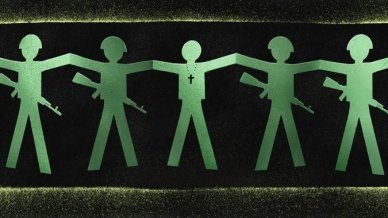
Chaplain Ribbon by Irena Mykoliv
About the Department
In 2014, the war with the russian federation began in the east of Ukraine and has continued up to these days. The Ukrainian Greek Catholic Church (UGCC) military chaplains immediately embarked on their mission to the war zone. Before the war, they had already worked with the Ukrainian military chaired by the Military Chaplaincy Department of the Patriarchal Curia of the UGCC.
The Department was created on October 3, 2006, at the Patriarchal Curia of the Ukrainian Greek Catholic Church. The aim was to develop, implement, and coordinate the up-and-running and effective pastoral care system for the military and UGCC adherents all over Ukraine.
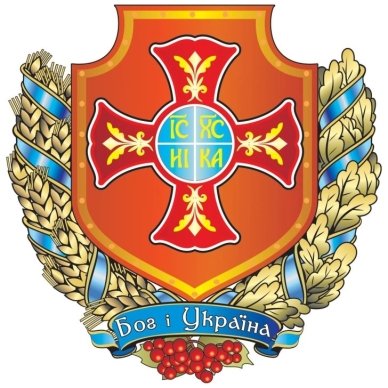
The sign of the Military Chaplaincy Department of the Patriarchal Curia of the UGCC
The Department’s priority was to meet the religious needs of the military people of faith and cooperate with national security, defense, and law enforcement agencies: Ministry of Defence of Ukraine, Ministry of Internal Affairs of Ukraine, Internal Troops of Ukraine, and State Border Guard of Ukraine.
The Military Chaplaincy Department of the Patriarchal Curia of the UGCC is responsible for systematizing and structuring the organization, dealing with education, and establishing interreligious denominational and international relations.
As a result, the institute of military chaplaincy in Ukraine was created. And it has continued performing its functions successfully these days, representing the interests of Ukrainian Greek Catholics at all levels.
Chaplaincy and Its Origins
“In the world, chaplains deal with forming the warrior’s personality, moral toughness, and spirit. And these are called humanity.”
Those words belong to Fr. Andrii Zelinskyi, Deputy Head of the Military Chaplaincy Department of the Patriarchal Curia of UGCC.
Priests in the war, or military chaplains, have existed for many years. Spiritual mentorship and moral support of people during wars and challenges are vital. In crises, human beings necessitate ethical benchmarks regardless of faith, time, and country.
Talking about Ukraine, His Beatitude Patriarch Liubomyr Huzar phrased the rule of Ukrainian chaplains. “Be there,” he said. It meant standing together in the war, in times of peace, and with those in need of support.
The word chaplain stems from the denomination of a coat type, a cape, a garment element of the Catholic clergy. According to the legend, Saint Martin (future archbishop of the city of Tours) shared such a coat with an unknown beggar, having torn it in halves. He saw that a man was cold and gave him what he had. That night, a young officer, who later became archbishop, saw a dream where the man he met called himself Jesus Christ and thanked him for his help. The second half of the cape of Martin from Tours became the holy relic of the French Army and was kept in a separate tent church or a capella. The serving priest was called capellanus and later a chaplain.
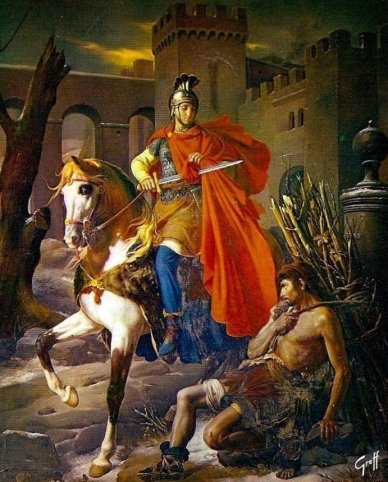
The painting features Martin of Tours cutting off a piece of his coat. Cathedral of Tours, France.
Every legion of Constantine the Great, the Roman emperor, had its own field church called capella; the denomination took roots instantly.
Since then, chaplains have existed in most armies of the world. Depending on the religion to which the soldiers adhere, the clergy can have different designated names, but the bottom line is the same. Salvation, psychological support moral and ethical discipling during tough times of wars and crises unite military priests (later in this text, you will find out that chaplains are not solely military clergy) around the globe.
The legal status of chaplaincy was rooted in 742-743 in Germany in the city of Regensburg during the first eastern Frankish synod called Consilium Germanicum. That meeting legalized the place of priests in military service but with a strict warning regarding weapons and their participation in armed conflicts.
As time passed, the clause about weapons varied by chaplains’ country and religious denomination. For example, modern Ukrainian chaplains (both Orthodox and Greek Catholic) are strictly forbidden to take weapons but only if it is for performing a combat mission. A chaplain can hold arms and even use them; if this saves people’s lives, it is not considered a sin. A weapon by itself is not evil. It is a tool, often consecrated for the protection of the homeland.
The first military chaplain in the Anti-Terrorist Operation Zone, Fr. Andrii Zelinskyi, says:
“Church teaches that demanding respect to our own right to life is legal. Important is the following: the one who protects their own life is not guilty of killing, even if this person is forced to deal a fatal blow to their opponent. I will explain. In the light of Christian studies, Lord has given me life, and it is His will. In other words, if I defend my life, I protect His will. When I am defending the lives of others, I am also protecting God’s will. To live is to have the right to life. If somebody resorts to violence to an extent higher than it is necessary for self-defense, their actions are illegal.”
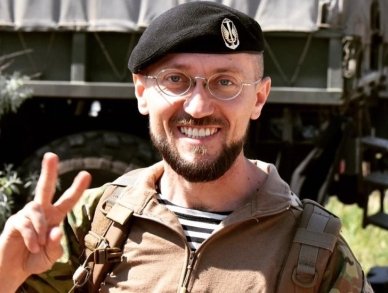
Fr. Andrii Zelinskyi, the photo is taken from the Ministry of Defense of Ukraine website
In the realities of modern russian-Ukrainian war, priests are supposed to choose whether to take weapons and resign or put them aside and remain serving as military chaplains. Though they say that there are no former priests, if the latter decide to use weapons, they continue to share their worldview with others.
Metropolitan Bishop Ioan of Cherkasy and Chyhyryn says:
“There is a range of chaplains who have chosen to be military men. They put off their chimers and crosses, mobilized through Military Commissar’s Offices, took weapons, and embarked on active duty according to their military qualifications. But there are no former priests. They continue their chaplaincy with weapons in their hands. And we have such men in our Cherkasy Eparchy.”
In some countries, chaplains are entitled to carry and use weapons, but the ones in Ukraine are unarmed as well as Ukrainian paramedics.
Abroad, there is a practice of appointing a member of the military with a service weapon to accompany a chaplain. In Ukraine, the procedure has just begun.
Altogether, those things are based on the Geneva Convention of 1949, according to which chaplains are not considered the persons taking part in armed conflicts. They retain their status in captivity and should be granted a right to continue their service among the captives. Using weapons automatically deprives them of this right.
A Brief History of Chaplaincy in Ukraine
The war in the east has become one of the incentives to develop and expand chaplaincy in modern Ukraine. However, chaplains had performed their services within its territory long before 2014. Military service in Ukraine, except in Soviet times, has always been under the spiritual oversight of the church. Chaplains acted in the units of Ukrainian Sich Riflemen, Ukrainian People’s Republic, Ukrainian Galician Army, Carpathian Sich, and Ukrainian Insurgent Army. Let us have a retrospective look.
During the times of Kyiv Rus, priests used to accompany the army in military campaigns and conduct services, which was repeatedly mentioned in the Hypatian Codex and Radziwiłł Chronicle.
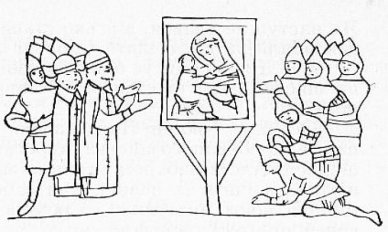
A prayer before the battle, 1767. Source: Radziwiłł Chronicle
During the era of the Grand Dutchy of Lithuania and the Polish-Lithuanian Commonwealth, a Roman Catholic priest always went along with prominent officers and their troops. Since some Ukrainian territories belonged to those countries and Ukrainian military men formed a part of their armies, they were also under the jurisdiction of local clergy.
Cossacks also had priests and monks of various faiths at kurins, Sich, and in their campaigns. They built the Churches of Intercession of the Most Holy Mother of God at every place where Sich settled.
When the russian empire emerged, religion became uniform within the annexed territories, and the army became dependent on the state church. The emperor issued the decree on those changes and further dependencies of the cossacks’ clergy on the russian army chief priest. The document was brought to Sich in 1760. However, cossacks managed to ignore it for some time.
Under those amendments, in 1719, chief priests began to be appointed in the russian military, and chief hieromonks appeared in the navy. The position of the army and navy chief priest emerged in 1858. And protopresbyters of the military and navy clergy came into being in 1890.
When compulsory military service was established in Austria during the Spring of Nations, church officials took care of the regular chaplains in Ukraine who satisfied the religious needs of the Greek Catholic military in times of peace and war.
On March 14, 1848, the Act on creating the territorial military units called the National Guard of Austria-Hungary was signed. In August of the same year, the celebratory consecration of the first Rus (Ukrainian) khorugv took place. There were the first merely Ukrainian clergy in exclusively Ukrainian armed units, though as a part of the Austrian army.
After that, the imperial army distinctly regulated the number of chaplains called feldkurats. They wore the military uniform with a cross and served as captains or majors, but without badges.
During WWI, around a hundred military chaplains were mentioned among Ukrainian soldiers as a part of the Austrian Imperial Troops, and most belonged to the Ukrainian Galician Army.
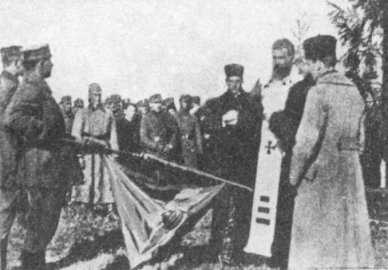
Sanctifying the flag of the Ukrainian Sich Riflemen by the Metropolitan Archbishop Andrey Sheptytsky in Rozvadov, August 28, 1917.
In Ukrainian People's Republic (UPR), a chaplain was a member of each two-kurin infantry regiment and three-sotnia cavalry regiment. In total, there were 44 military priests. Initially, Fr. Antonii Mateyuk became the UPR’s protopresbyter (chief chaplain). After his death, his successor was Fr. Pavlo Pashchevskyi, an Orthodox priest, chaplain of the First Ukrainian Reserve Regiment of the UPR’s Army, and later — of the Petro Doroshenko Serdiuk Regiment.
Since WWII, we have known many names. There is Fr. Sebastian Sabol (Zoreslav) in Carpathian Sich, Fr. Ivan Hrynokh and Fr. Ivan Dubrak in the Legions of Ukrainian Nationalists divisions and Roland and Nachtigall Wehrmacht regiments. There are also the names of chaplains of the Halychyna Division led by Fr. Vasyl Laba, appointed by Metropolitan Andrei Sheptytsky. The latter supported the idea of forming the Ukrainian division and pronounced these well-known words: “There is almost no price not to be paid for the creation of the Ukrainian army.”
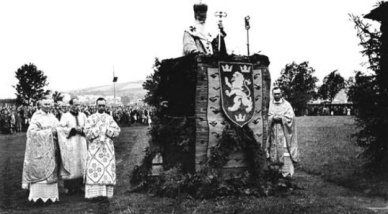
Przemysl Bishop Josaphat Kotsylovsky is blessing the SS Halychyna Division.
The very fact of the emergence of chaplains in the SS units was a precedent because no other division had a priest. The service of the Greek Catholic clergy in the division decreased the influence of Nazi propaganda on the Ukrainian military and, in that way, kept their national and religious spirit.
There were also chaplains in the Ukrainian Insurgent Army.
The Soviet Army denied the church, and atheism was one of the pillars of communism. However, the Soviet authorities turned a blind eye to the soldiers' contact with the Orthodox priests during the war. When it ended, those liaisons ceased to exist.
Military Chaplains in Independent Ukraine. Legal Aspect
In the modern world, a range of international legal instruments regulate religious freedom principles, for example, Article 18 of the Universal Declaration of Human Rights, Article 18 of the International Covenant on Civil and Political Rights, Declaration on the Elimination of All Forms of Intolerance and of Discrimination Based on Religion or Beliefs, Article 9 of the European Convention on Human Rights. Implementation of human freedoms depends on the tool of their legal provision and state protection.
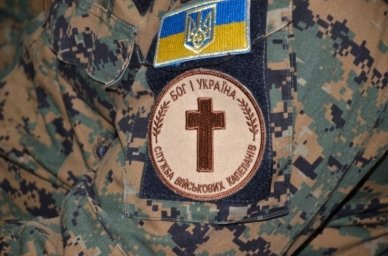
The chevron of a chaplain of the Ukrainian Armed Forces
Ukraine, acting through its Ministry of Defense, guarantees the right declared in the Constitution of Ukraine. The right to freedom of thought and religion has been entrenched for the citizens of modern Ukraine in Article 35 of the Constitution of Ukraine: “Everyone has the right to freedom of thought and religion. This right includes the freedom to profess or not to profess any religion, to perform alone or collectively and without constraint religious and ceremonial rituals, and to conduct religious activity.” However, the institute of chaplaincy in Ukraine is not totally protected on a social level. Neither is it engraved in the system.
Chaplains who serve in the Armed Forces of Ukraine and other state military units ought to have the right to social protection as the military do. It is regulated by the law that had to enter into force on July 1, 2022. However, as martial law has been declared due to an active phase of military operations, the process was put on pause.
Fr. Ioan said in the interview:
“We expected the law to be enforced after the urgent reading and signing by the President. But the institutions responsible for that did not snap to action, and now, there is no military occupational specialty. That is why our chaplains cannot be military officers officially.”
Before March 2022, military chaplains had been officially considered civil employees. Though the permanent appointment of a chaplain in the army was identical to the position of a battalion or regiment deputy commander, chaplains are simultaneously AFU officers and clergy.
The changes do take place, but slower than expected. Let us look at the chronology of chaplaincy origins in independent Ukraine.
On May 12, 1994, in Lviv, the International Scientific Symposium on religious and humanitarian issues of the Ukrainian Armed Forces took place in Lviv. As a result, the Parachurch Council on Pastoral Care in the Armed Groups of Ukraine was established as a regular advisory body representing different religions in pastoral care matters in the Armed Forces of Ukraine.
In March 1995, the International Scientific and Practical Conference “Army and Religion: Freedom of Conscience and Religion” was held in Kyiv to discuss the issue of satisfying religious rights and freedoms in the Ukrainian army.
In two years, also in the capital city, the Second International Scientific and Practical Conference “Christian Love and Military Duty” was conducted, where they discussed how pastoral care of the military should function in Ukraine.
Between September 23 and 25, 1999, Kyiv again became the venue for the Third International Scientific and Practical Conference: “Practice of Forming the Personality of a Military Person and Creating the Conditions for Successful Performance of Military Duty: Christian Experience.” Participants discussed the ways of cooperation and the effect of religion on the military.
There were the clergy, the army, authorities, scholars, and the delegates of foreign countries where the chaplaincy was already functioning at the legislative level.

The chevron of a Ukrainian chaplain
Following those debates, the Conference appealed to the President of Ukraine — the Supreme Commander-in-Chief of the Armed Forces of Ukraine (as of that time, Leonid Kuchma) with the following suggestions:
- to elaborate a concept of pastoral activities of military priests in the armed groups of Ukraine (three parties — the State Committee on Religion, security, defense, and law enforcement agencies, and representatives of religious denominations — had to develop their concepts to be then discussed);
- based on the agreed concept, to make amendments to the Law of Ukraine “On the Freedom of Thought and Religious Organizations”;
- based on those amendments, to create a clause about the institute of chaplaincy in military agencies and write additions to the Statutes of the Armed Forces of Ukraine;
- under the aegis of the State Committee on Religion or the Ukrainian Council of Churches and Religious Organizations, to establish a corresponding body that will be responsible for pastoral care about the military;
- to initiate the opening of churches, chapels, and sacred services at military bases.
On October 11-13, 2000, the Anniversary International Military and Christian Conference took place in Lviv. Representatives of religious denominations, traditional for Ukraine, established the All-Ukrainian Interreligious Christian-Military Brotherhood and enforced its activity in December 2000. Their aim was to take measures to develop the Ukrainian military chaplaincy at the state and lawful levels and elaborate a common approach to meeting the religious needs of the military. The Brotherhood is a member of the Association of Christian Military Fellowships (ACMF).
The first thing they did was a project on conceptual bases of pastoral care about the religious military. They also conducted training of the chaplaincy reserve for the AFU and formulated the common vision of the chaplaincy future in all religious denominations that united in the brotherhood.
In May 2000, the Christian Military Union was registered and involved those who served in the army at that time and their families, and those who retired. The organization was created to protect the rights and freedoms of the military, promote Christian and moral values, and form the bases for military chaplaincy in Ukraine.
A critical document that regulated the mechanism for meeting the religious needs of the faithful military for the first time in the history of independent Ukraine became the Directive of the Minister of Defense of Ukraine No.D-25 “On Harmonizing the Issues of Meeting the Religious Needs of the Ukrainian Armed Forces Military” of April 21, 2006.
On November 1, 2008, the division of collaboration with religious organizations appeared in the structure of the Humanitarian Policy Department of the Ministry of Defence.
In November 2008, the Memorandum of Cooperation in the Matters of Pastoral Care of the Ukrainian Armed Forces Military was signed by the Ministry of Defense of Ukraine and representatives of Ukrainian churches and religious organizations. The intent to create the military chaplaincy institute in Ukraine was officially declared for the first time.
Under the Memorandum, the aim was to provide the constitutional right of the military to the freedom of conscience.
On November 30 of the same year, Verkhovna Rada of Ukraine adopted the Law “On the Service of Military Chaplaincy.” In December 2020, the Doctrine “On Military Leadership Development in the Armed Forces of Ukraine” was published. Those two documents together had to form a value-oriented and strategic platform for the Ukrainian army.
The two instruments mentioned above emerged owing to Fr. Andrii Zelinskyi, the adviser of the UGCC Head, Deputy Head of the Military Chaplaincy Department of the Patriarchal Curia of the UGCC, a co-founder, lecturer, and member of the Initiative Group and Supervisory Board of the Ukrainian Leadership Academy, a political expert, a publicist, an author, a community activist, and the ATO Stuff first military chaplain in 2014.
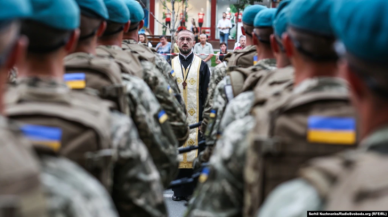
Fr. Andrii Zelinskyi
On April 29, 2009, the Pastoral Care Council at the Ministry of Defense of Ukraine was established to improve the effectiveness of cooperation between religious organizations regarding military chaplaincy.
Decree No.220 of the Minister of Defense of Ukraine on April 22, 2011, ratified the Ukrainian Armed Forces Pastoral Care Concept. It was for the first time that the document defined a range of essential matters to be equally interpreted by all religious denominations of Ukrainian chaplaincy.
On December 29, 2012, the National Security and Defense Council of Ukraine adopted the Draft Concept of Reforming and Development of the Armed Forces of Ukraine till 2017.
During 2014 and 2015, there were attempts to expand the legislative basis of exercising the rights of military chaplains. A few issue-related laws-in-draft were submitted for consideration to the Verkhovna Rada of Ukraine. However, they were either outdated (taking into account the development of military actions on the country’s east) or incorrect, so failed as a result.
In May 2017, a permanent appointment of a military chaplain officially emerged at the legislative level corresponding to the position of deputy commander of a regiment or a battalion.
On June 6, 2019, the Verkhovna Rada of Ukraine adopted Law No.10244-1 “On Military Chaplaincy” at the first reading. The instrument was intended to provide administrative and legal guarantees of the military chaplaincy institute, social security of military chaplains, and chaplaincy in general.
On November 30, 2021, Verkhovna Rada adopted Law No.4626 “On Military Chaplaincy Service” supported by 291 People’s Deputies of Ukraine: Twitter.
“This Law regulates the relationships in the sphere of exercising the constitutional right to freedom of thought and religion of the Armed Forces of Ukraine military, the National Guard of Ukraine, and other military groups created under the laws of Ukraine, State Border Guard Service of Ukraine, and also defines legal and organizational bases and principles of the Military Chaplaincy Service activity”.
Now, the Military Chaplaincy Service is a separate structure within the Armed Forces of Ukraine, the National Guard, and other groups formed according to Ukrainian legislation.
Chaplains are subordinate to the Commander-in-Chief of the Armed Forces of Ukraine, the National Guard Commander, the commanders of other military groups created pursuant to Ukrainian laws, and the Head of the State Border Guard Service of Ukraine.
To become a military chaplain, a person has to be a citizen of Ukraine and clergy of a religious organization registered in Ukraine. This individual shall also have a mandate given by the leading centre (management) of a respective religious organization to conduct military chaplaincy activities. It is a must for a chaplain to have higher education with a degree in Theology (this regulatory provision comes into force in 2026).
On December 17, 2021, President Volodymyr Zelenskyi of Ukraine held a meeting with the representatives of the Ukrainian Church Council and signed the Law “On Military Chaplaincy Service”, which was approved by Verkhovna Rada of Ukraine on November 30, 2021.
This Law:
- entrenches the status of military chaplains as military persons,
- defines their functional duties,
- establishes quotas of religious denomination representation according to the personnel needs considering the number of religious denominations functioning in the state,
- presumes to create Interreligious Denominational Military Chaplaincy Councils as advisory bodies at the Ministry of Defense and Ministry of Internal Affairs of Ukraine.
The Law was supposed to come into force on July 1, 2022. But the procedure was placed on pause because of the declaration of martial law in Ukraine. However, Verkhovna Rada of Ukraine had time to make amendments to the Transitional Provisions of the Act, and thus it entered into effect on March 19, 2022. Some of its provisions came into force in the middle of March this year during the war. Chaplains now are officers and clergy at the same time.
Major Archbishop of the Ukrainian Greek-Catholic Church, Sviatoslav, says that “the Law on Military Chaplaincy provides a priest’s presence in military formations on a professional and constant basis. A military chaplain becomes an officer of the Armed Forces of Ukraine. Though it is an opportunity, it is also a challenge because a chaplain, even when an officer, should remain a priest. And here emerges a great task for those who select the respective candidates and look for those who are truly called to such a service. Thus, chaplains should be prepared in a certain way so that they do not become similar to the officers. They should keep their spiritual image being AFU officers.
Modern Ukrainian Chaplains
These days, Ukrainian military chaplains are not about theoretical reflections within a legal framework and not about historical tribute to the tradition. They are more than reality.
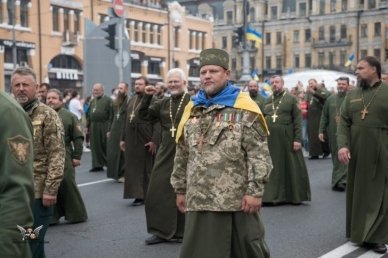
Ukrainian chaplains at the March of the Defenders. Photo: Spiritual Front of Ukraine
Since 2014, Ukraine has been at war that reached its active phase on February 24, 2022. Chaplains are priests, volunteers, suppliers, stand-in psychologists, drivers, comrades, and those who “are always there”, as Liubomyr Huzar said. They are always there in a trench, a prayer, next to the wounded, and in the war.
The adherents of all faiths are fighting in the war now. There are Muslims, Jewish, Greek Catholics, and the Orthodox of the Moscow Patriarchate. For that reason, chaplaincy is interreligious. A chaplain should help everyone in need. If he cannot do this within their religious denomination, he has to find a priest of the necessary religion.
There are in-service chaplains and volunteers. In 2014, military chaplains were solely volunteers who went to the war on the first days together with the soldiers. To go to places where something has happened to help others has been commonplace. Now, the position of a military chaplain is better regulated (but not completely) at the legislative level. As a result, the number of in-service chaplains is higher than the one of volunteers.
Both categories should be delegated from the management of their religious denominations because the latter bears responsibility. Besides, a chaplain is supposed to have pastoral care experience verified by law enforcement agencies. The religious needs of Ukrainian citizens are entrenched in the Constitution. The State enforces the process by acting through the Department of Moral and Psychological Support on the General Staff.
As a rule, when people talk about chaplains, they mean exactly the military ones. However, they belong only to one out of seven directions of chaplaincy. The six remaining groups are as follows:
- navy chaplains serving in large ports;
- police chaplains working with police;
- municipal chaplains cooperating with local governments;
- prison chaplains serving in prisons and detention centres;
- sports chaplains working with teams and sports clubs;
- hospital chaplains working in hospitals.
Chaplaincy in Ukraine is a relatively new sphere, though the tradition itself is ancient. It is difficult to overestimate the contribution of military chaplains and the significance of their everyday service at the front and behind the lines, particularly now, when the war has touched every Ukrainian.
The Military Chaplaincy Department of the Patriarchal Curia of the Ukrainian Greek Catholic Church exists to integrate chaplaincy as an official institute, form a certain social framework, and undoubtedly enable the Greek Catholics to realize their religious needs. The Department is constantly developing with the usage of new ways of communication with its people like social networks, media, and interviews.
Contact information
Bishop Mykhail (Koltun) – Head of the Department
Charity Organization Fundatsiia Arkhystratyha Mykhaila
Address: 02002, Ukraine, Kyiv, 4H Mykilsko-Slobidska Street, Office 16
- Director
- Liubomyr Yavorskyi
- Phone
- +380445411127
- [email protected]
Society of Jesus, Deputy Head of the Department
- Fr. Andrii Zelinskyi
- Phone
- +380673130820
- [email protected]
Head of the Department for Pastoral Care of the Penitentiary System of Ukraine
- Fr. Kostinatyn Pantelei
- Phone
- +380984229221
Heads of Pastoral Affairs of the Department
- Fr. Rostyslav Vysochan
- Phone
- +380971437008
- [email protected]
- Colonel Oleksandr Melnyk
- Phone
- +380965688880
- [email protected]

